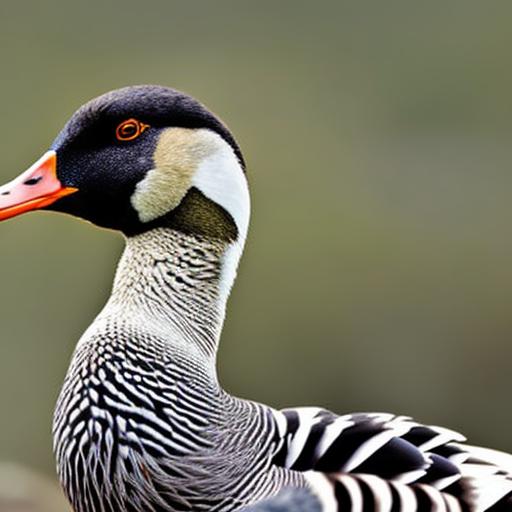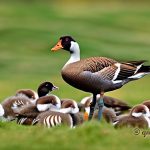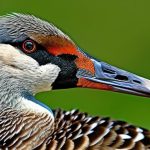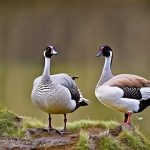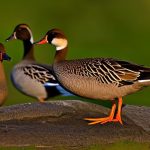North America is home to a diverse range of geese breeds, each with its own unique characteristics and adaptations. Some of the most common breeds found in North America include the Canada Goose, Snow Goose, and Brant Goose. These geese play a significant role in North American culture, with their distinctive honking calls and graceful flight patterns often serving as a symbol of the wild and untamed beauty of the continent.
The Canada Goose is perhaps the most well-known breed of goose in North America. It is easily recognizable by its large size, black head and neck, white chinstrap, and brownish-gray body. The Snow Goose, on the other hand, is known for its pure white plumage, although some individuals may have dark feathers on their wings. The Brant Goose is smaller in size compared to the Canada Goose and has a dark body with a white patch on its neck.
Geese have long been an important part of North American culture. They have been depicted in Native American art and folklore, and their feathers have been used for ceremonial purposes. In addition, geese hunting has been a popular recreational activity for many years, with hunters eagerly awaiting the arrival of migrating geese each year. Overall, geese are deeply ingrained in the cultural fabric of North America.
Key Takeaways
- North American geese are a diverse group of waterfowl that play important roles in ecosystems and agriculture.
- These geese have distinct physical characteristics, including different sizes, colors, and beak shapes.
- North American geese are known for their impressive migration patterns, which can span thousands of miles.
- Breeding habits vary among different geese breeds, with some forming lifelong pair bonds and others mating with multiple partners.
- Threats to North American geese populations include habitat loss, hunting, and climate change, but conservation efforts are underway to protect these important birds.
Physical Characteristics of North American Geese
North American geese vary in size, weight, and coloration. The Canada Goose is one of the largest species of geese in North America, with males weighing between 7 and 14 pounds and females weighing between 6 and 12 pounds. Snow Geese are slightly smaller, with males weighing between 5 and 7 pounds and females weighing between 4 and 6 pounds. Brant Geese are even smaller, with males weighing between 3 and 5 pounds and females weighing between 2 and 4 pounds.
In terms of coloration, Canada Geese have a distinctive black head and neck, white chinstrap, and brownish-gray body. Snow Geese are mostly white, although some individuals may have dark feathers on their wings. Brant Geese have a dark body with a white patch on their neck.
Geese also have unique features such as their beak shape and feather patterns. The beak of a goose is designed for grazing on grasses and other vegetation. It is flat and broad, with serrated edges that help them tear off pieces of vegetation. Geese also have webbed feet, which enable them to swim efficiently in water.
The Migration Patterns of North American Geese
One of the most fascinating aspects of North American geese is their annual migration. Each year, millions of geese travel thousands of miles from their breeding grounds in the Arctic to their wintering grounds in the southern United States and Mexico. This migration is driven by the need to find food and suitable nesting sites.
During migration, geese fly in a V-formation, which helps them conserve energy by taking advantage of the updraft created by the bird in front of them. This allows them to fly long distances without tiring. Geese also navigate using a combination of visual landmarks, such as rivers and mountains, and their internal compass, which is believed to be based on the Earth’s magnetic field.
The Role of North American Geese in Ecosystems
North American geese play a crucial role in maintaining the health of wetland ecosystems. They are herbivores that primarily feed on grasses, sedges, and other vegetation found in wetland habitats. By grazing on these plants, geese help control their growth and prevent them from becoming overgrown.
In addition, geese contribute to nutrient cycling in wetland ecosystems. When they consume plant material, they excrete waste that contains nutrients such as nitrogen and phosphorus. These nutrients are then released into the soil, where they can be taken up by other plants, helping to maintain the overall health and productivity of the ecosystem.
Breeding Habits of North American Geese
Breeding among North American geese typically occurs during the spring and summer months. Mating rituals often involve elaborate displays, with males performing various behaviors to attract females. These displays can include honking, head bobbing, and wing flapping.
Once a pair has formed, they will search for a suitable nesting site. Geese typically build their nests on the ground, near water sources such as lakes or rivers. The female will lay a clutch of eggs, usually between 4 and 8, and both parents will take turns incubating the eggs for about a month.
The Importance of North American Geese in Agriculture
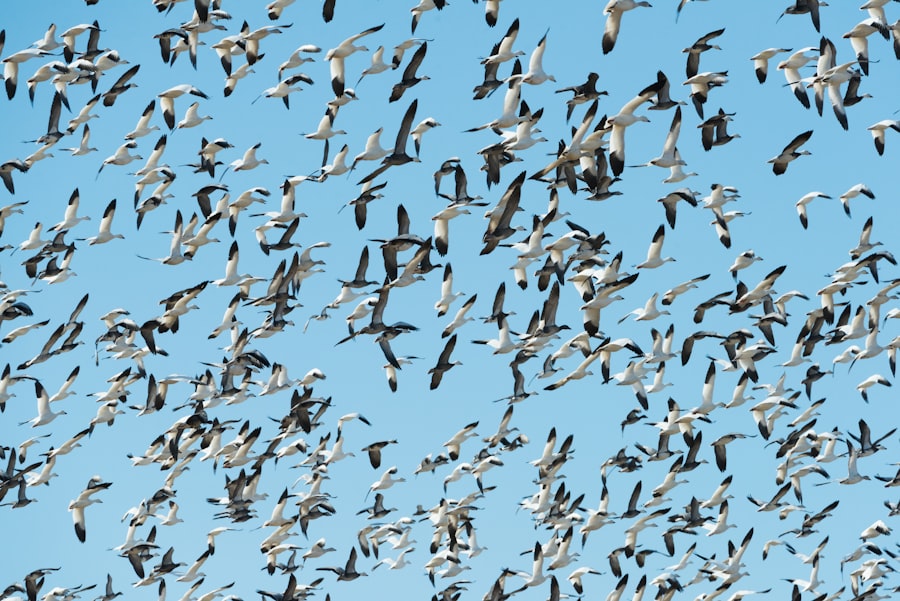
North American geese have long been used in agriculture for meat and egg production. Goose meat is considered a delicacy in many cultures and is often used in traditional dishes. Goose eggs are also prized for their large size and rich flavor.
The goose industry has a significant economic impact in North America. Goose farming provides employment opportunities for many people, from farmers who raise geese to workers involved in processing and marketing goose products. In addition, goose hunting is a popular recreational activity that generates revenue through licenses and permits.
Threats to North American Geese Populations
Despite their importance, North American geese face several threats that have led to declines in their populations. Habitat loss and degradation are major concerns, as wetlands are being drained or converted for agriculture and urban development. This loss of habitat reduces the availability of suitable nesting sites and food sources for geese.
Hunting and poaching also pose a threat to geese populations. Although regulated hunting can be sustainable, illegal hunting and poaching can have devastating effects on goose populations. Climate change is another significant threat, as it is altering the timing and duration of migration patterns. Changes in temperature and precipitation can affect the availability of food and nesting sites, making it more difficult for geese to survive and reproduce.
Conservation Efforts for North American Geese
To protect North American geese populations, various government and non-governmental organizations are working to conserve their habitats and implement sustainable hunting practices. These efforts include habitat restoration and protection, such as the creation of protected areas and the restoration of wetlands.
In addition, educational programs are being implemented to raise awareness about the importance of geese and the need for their conservation. These programs aim to promote responsible hunting practices and encourage individuals to support conservation efforts.
The Economic Impact of North American Geese
North American geese have both positive and negative economic impacts. On one hand, goose hunting and tourism generate revenue through licenses, permits, and tourism activities such as birdwatching. Many people travel to areas where geese are abundant to observe their behavior and enjoy their beauty.
On the other hand, geese can also cause damage to crops and property. Their grazing habits can lead to crop losses for farmers, while their droppings can create sanitation issues in urban areas. The cost of damage caused by geese can be significant, requiring measures such as scare tactics or physical barriers to deter them from certain areas.
North American Geese in Popular Culture
North American geese have made appearances in various forms of popular culture, including literature, film, and music. They are often depicted as symbols of freedom, wildness, and the beauty of nature. In literature, geese have been featured in works such as E.B. White’s “The Trumpet of the Swan” and Richard Bach’s “Jonathan Livingston Seagull.”
In film, geese have been portrayed in movies such as “Fly Away Home,” which tells the story of a young girl who raises a flock of orphaned geese and teaches them to migrate. Geese have also been referenced in numerous songs, with their distinctive honking calls often used to evoke a sense of nostalgia or longing for the natural world.
North American geese are not only beautiful and majestic creatures, but they also play a vital role in ecosystems, agriculture, and culture. Their annual migration patterns are a testament to their resilience and adaptability, as they travel thousands of miles each year in search of food and suitable nesting sites. Geese contribute to the health of wetland ecosystems by controlling plant growth and cycling nutrients. They are also important in agriculture, providing meat and eggs that are enjoyed by many people.
However, North American geese face numerous threats, including habitat loss, hunting, and climate change. Conservation efforts are underway to protect their habitats and promote sustainable hunting practices. It is important for individuals to support these efforts and appreciate the beauty and importance of these magnificent birds. By doing so, we can ensure that future generations will continue to be able to witness the wonder of North American geese in all their glory.
If you’re interested in learning more about North American geese breeds, you might also enjoy reading this article on the Poultry Wizard website: The Chicken Coop Country Diner. This informative piece discusses the various breeds of geese found in North America and provides valuable insights into their characteristics, behavior, and care. Whether you’re a poultry enthusiast or simply curious about these fascinating birds, this article is sure to provide you with interesting information.
FAQs
What are North American geese breeds?
North American geese breeds are a group of goose species that are native to North America. They are known for their distinctive appearance, behavior, and habitat.
How many North American geese breeds are there?
There are eight North American geese breeds, including the Canada goose, snow goose, Ross’s goose, cackling goose, brant, greater white-fronted goose, lesser white-fronted goose, and emperor goose.
What is the most common North American geese breed?
The Canada goose is the most common North American geese breed. They are found throughout North America and are known for their distinctive black head and neck, white chinstrap, and brown body.
What is the habitat of North American geese breeds?
North American geese breeds are found in a variety of habitats, including wetlands, marshes, lakes, rivers, and fields. They are migratory birds and travel long distances to breed and feed.
What do North American geese breeds eat?
North American geese breeds are herbivores and primarily feed on grasses, sedges, and aquatic plants. They also eat grains, seeds, and berries.
What is the lifespan of North American geese breeds?
The lifespan of North American geese breeds varies depending on the species. Canada geese can live up to 24 years in the wild, while snow geese have a lifespan of up to 15 years.
Are North American geese breeds protected?
Yes, North American geese breeds are protected under the Migratory Bird Treaty Act of 1918. It is illegal to hunt, capture, or kill them without a permit.
Meet Walter, the feathered-friend fanatic of Florida! Nestled in the sunshine state, Walter struts through life with his feathered companions, clucking his way to happiness. With a coop that’s fancier than a five-star hotel, he’s the Don Juan of the chicken world. When he’s not teaching his hens to do the cha-cha, you’ll find him in a heated debate with his prized rooster, Sir Clucks-a-Lot. Walter’s poultry passion is no yolk; he’s the sunny-side-up guy you never knew you needed in your flock of friends!

